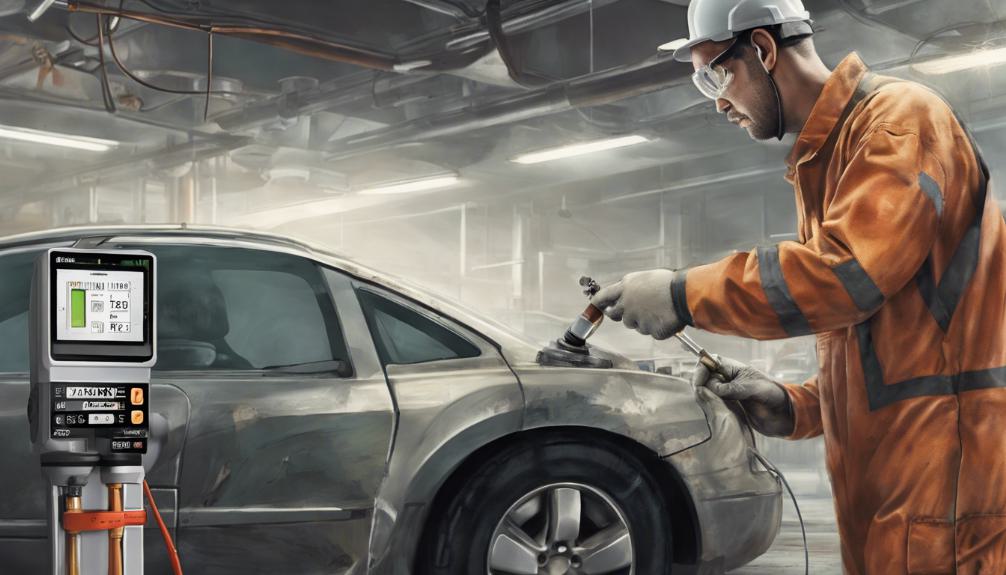If warning lights like Check Engine or oil indicator are on, along with trouble starting your engine, you might have oil level sensor issues.
Addressing these symptoms promptly is crucial for your vehicle’s performance. Understand oil pressure warning lights like p0520, p0522, or p0523 that may show sensor failures. Regularly monitor oil levels to prevent engine harm.
Diagnose sensor malfunctions by using a diagnostic scanner and checking sensors and wiring. Expertly replace faulty sensors to guarantee your engine’s health. Proper attention to these signs guarantees a well-functioning vehicle.
What You Need to Know
- Warning lights like Check Engine or oil light indicate sensor issues promptly.
- False alerts may occur due to a malfunctioning sensor triggering warnings.
- Difficulty starting the engine could be a sign of sensor problems.
- Timely attention from a mechanic is crucial for resolving sensor issues.
- Proper replacement of faulty sensors is vital for accurate oil level monitoring.
Common Symptoms of Oil Level Sensor Issues

Have you ever wondered how to identify common symptoms of oil level sensor issues in your vehicle?
When your oil level sensors start acting up, they can trigger warning lights on your dashboard, such as the oil warning light or the Check Engine light.
These indicators are vital in alerting you to potential problems with your oil level sensors.
If you notice these lights coming on despite having the correct oil levels, it could be a sign of a malfunctioning sensor.
Another symptom to watch out for is difficulty starting your engine, which might be directly linked to faulty oil level sensors.
It’s essential to address these issues promptly by seeking assistance from a qualified mechanic. Ignoring problems with your oil level sensors can lead to more significant complications down the road.
By understanding these common symptoms and taking quick action, you can make sure that your vehicle’s oil level sensors are functioning correctly and avoid potential engine damage.
Understanding Oil Pressure Warning Lights
The oil pressure warning lights in your vehicle serve as important indicators of potential issues with the oil pressure in the engine.
If the oil light on your dashboard comes on and stays on, it could signal a problem with the oil pressure sensor, indicating low oil pressure in the engine.
In some cases, error codes like p0520, p0522, or p0523 may be associated with oil pressure sensor failures.
If you notice the oil light blinking repeatedly, this could also be a sign that the sensor is bad and needs attention.
Checking the oil level and pressure physically is vital to ensure the engine is adequately lubricated, preventing potential damage.
Promptly replacing a faulty oil pressure sensor is essential to maintain accurate monitoring of the engine oil pressure, ensuring the longevity and proper functioning of your vehicle.
Importance of Accurate Oil Level Monitoring

Accurately monitoring your vehicle’s oil level is essential for preventing engine damage and ensuring smooth operation of moving parts.
Here are three key reasons highlighting the importance of accurate oil level monitoring:
- Preventing Engine Damage: Maintaining the correct oil level in your vehicle is necessary to lubricate the engine’s components properly.
Without adequate lubrication, increased friction can lead to overheating and accelerated wear and tear on crucial parts, ultimately causing severe engine damage.
- Avoiding Costly Repairs: Proper oil levels help prevent costly repairs by ensuring that the engine functions efficiently.
Regularly checking the oil level and relying on the oil level sensor alerts can save you from unexpected breakdowns and hefty repair bills.
- Ensuring Engine Longevity: Monitoring your oil level through the sensor not only safeguards your engine from immediate harm but also contributes to its long-term health.
Consistent oil level checks and sensor maintenance play a significant role in extending the longevity of your vehicle’s engine.
Diagnostic Steps for Sensor Malfunctions
To diagnose sensor malfunctions effectively, start by using a diagnostic scanner to retrieve error codes related to oil level sensor issues.
This step will provide valuable information about potential problems within the sensor system.
Next, conduct a visual inspection of the oil level sensor and its wiring. Look for any signs of damage or corrosion that could be affecting its proper functioning.
Following this, perform an oil pressure test to verify that the sensor is accurately detecting the oil levels in the vehicle. It’s important to confirm that the sensor is sending correct signals to the vehicle’s system.
Test the sensor’s electrical connection to validate it’s properly working and communicating with the vehicle’s onboard computer.
Then, consulting the vehicle’s manual can offer specific troubleshooting steps and guidance on how to replace a faulty oil level sensor if necessary.
Replacement Options for Faulty Sensors

If you encounter a faulty oil level sensor, exploring replacement options is the next step in guaranteeing proper functioning and maintenance of your vehicle. Here are some options to ponder:
- Manufacturer Replacement: You can opt for a new sensor directly from the vehicle’s manufacturer. This ensures compatibility and quality but may come at a higher cost.
- Aftermarket Suppliers: Another choice is to purchase a replacement sensor from aftermarket suppliers. These options may vary in quality and price, so research is essential to find a reliable one.
- Professional Installation: It’s recommended to have the replacement sensor installed by a professional mechanic.
This guarantees the correct installation and functionality of the new sensor, avoiding any potential issues that could arise from improper replacement.
When choosing a replacement sensor, quality is key to maintaining accurate oil level monitoring and preventing engine damage.
Whether you decide to DIY with proper guidance or seek professional help, making sure the sensor is correctly replaced is vital for the overall health of your vehicle.
Professional Repairs for Long-Term Solutions
For long-lasting solutions to oil level sensor issues, entrusting your vehicle to skilled mechanics for professional repairs is essential.
When the oil level sensor malfunctions, necessary repairs should be carried out promptly to avoid potential damage to your engine.
Skilled mechanics can accurately diagnose the issue and determine the best course of action to rectify it.
Once the necessary repairs are identified, expert technicians have the knowledge and tools to efficiently replace the faulty oil level sensor, ensuring that your engine is running smoothly and with accurate oil level readings.
Trusted auto service centers like Future Auto Service specialize in providing reliable solutions for oil level sensor problems.
By opting for professional repairs, you not only address the current issue but also prevent costly engine repairs in the future.
Timely intervention and expert care for your oil level sensor can save you money in the long run and help maintain the overall health and performance of your vehicle.
Trusting skilled mechanics for professional repairs guarantees a long-term solution to your oil level sensor issues.
As an Amazon Associate we earn from qualifying purchases.










